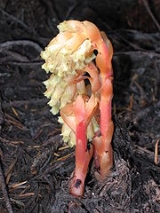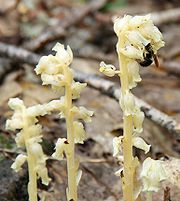
Monotropa hypopitys
Encyclopedia
Monotropa hypopitys, also known as Dutchman's Pipe, Yellow Bird's-nest or Pinesap, is a herbaceous
perennial plant
, formerly classified in the families Monotropaceae or Pyrolaceae, but now included within the subfamily Monotropoidiae of the blueberry family (Ericaceae
). It is native to temperate regions of the Northern Hemisphere
, and is scarce or rare in many areas. However, it is still the most widespread member of the subfamily. While currently included in the genus Monotropa
, recent genetic evidence strongly suggests that Monotropa hypopitys should be placed in its own genus, Hypopitys, with the single species Hypopitys monotropa Crantz, but possibly containing several other species.

 Unlike most plants, it does not contain chlorophyll
Unlike most plants, it does not contain chlorophyll
; it is a myco-heterotroph, getting its food through parasitism
upon fungi rather than photosynthesis
. These fungi form a mycorrhiza
with nearby tree species.
Plants are fleshy and grow 10–35 cm tall. True stems are nonexistent. Instead, the only part which emerges from the soil are unbranched adventitious inflorescences
which are developmentally similar to adventitious roots. All parts of the plant are pale yellowish white to reddish-tinged. The bracts
are 5–10 mm long scale-like structures, which cover most of the inflorescence. Plants flower from April to December depending on the geographic region (June to September in North America). The flower
s are pendulous when young, but become erect when they begin to mature into the fruit
which is a capsule. The flowers are 9–12 mm long and produced in a cluster of 1–11 together at the apex of the inflorescence, which is a raceme
. It flowers between early summer and mid autumn; plants that flower in summer are yellow and sparsely hairy, while those that flower in autumn are red and densely hairy. These two color "forms" overlap in flowering time. It has been suggested that yellow individuals are largely self-pollinating.
The species name is from Latin
ized Greek
hypo-, "under", and pitys, "pine
", referring to where pinesap often grows. However, Linnaeus misspelled it hypopithys. Many authorities have followed his spelling. On the other hand, it has been stated that the spelling "is generally treated as correctable to 'hypopitys'", as followed by other authorities. The variability of the species in colour, hariness, and in the number of flowers, has led to an extensive synonymy for the species. The entire list is over 80 synonyms; some of which include Hypopitys americana, H. fimbriata, H. insignata, H. lanuginosa, H. latisquama, H. monotropa, Monotropa chinensis, M. hypophegea, M. lanuginosa, M. latisquama, M. multiflora and M. taiwaniana.
In California, Monotropa hypopitys may be confused for the much less common Pityopus
or Hemitomes
which are superficially similar.
Herbaceous
A herbaceous plant is a plant that has leaves and stems that die down at the end of the growing season to the soil level. They have no persistent woody stem above ground...
perennial plant
Perennial plant
A perennial plant or simply perennial is a plant that lives for more than two years. The term is often used to differentiate a plant from shorter lived annuals and biennials. The term is sometimes misused by commercial gardeners or horticulturalists to describe only herbaceous perennials...
, formerly classified in the families Monotropaceae or Pyrolaceae, but now included within the subfamily Monotropoidiae of the blueberry family (Ericaceae
Ericaceae
The Ericaceae, commonly known as the heath or heather family, is a group of mostly calcifuge flowering plants. The family is large, with roughly 4000 species spread across 126 genera, making it the 14th most speciose family of flowering plants...
). It is native to temperate regions of the Northern Hemisphere
Northern Hemisphere
The Northern Hemisphere is the half of a planet that is north of its equator—the word hemisphere literally means “half sphere”. It is also that half of the celestial sphere north of the celestial equator...
, and is scarce or rare in many areas. However, it is still the most widespread member of the subfamily. While currently included in the genus Monotropa
Monotropa
Monotropa is a genus of two species of herbaceous perennial plants, formerly classified in the family Monotropaceae, but now included within the Ericaceae...
, recent genetic evidence strongly suggests that Monotropa hypopitys should be placed in its own genus, Hypopitys, with the single species Hypopitys monotropa Crantz, but possibly containing several other species.


Chlorophyll
Chlorophyll is a green pigment found in almost all plants, algae, and cyanobacteria. Its name is derived from the Greek words χλωρος, chloros and φύλλον, phyllon . Chlorophyll is an extremely important biomolecule, critical in photosynthesis, which allows plants to obtain energy from light...
; it is a myco-heterotroph, getting its food through parasitism
Parasitism
Parasitism is a type of symbiotic relationship between organisms of different species where one organism, the parasite, benefits at the expense of the other, the host. Traditionally parasite referred to organisms with lifestages that needed more than one host . These are now called macroparasites...
upon fungi rather than photosynthesis
Photosynthesis
Photosynthesis is a chemical process that converts carbon dioxide into organic compounds, especially sugars, using the energy from sunlight. Photosynthesis occurs in plants, algae, and many species of bacteria, but not in archaea. Photosynthetic organisms are called photoautotrophs, since they can...
. These fungi form a mycorrhiza
Mycorrhiza
A mycorrhiza is a symbiotic association between a fungus and the roots of a vascular plant....
with nearby tree species.
Plants are fleshy and grow 10–35 cm tall. True stems are nonexistent. Instead, the only part which emerges from the soil are unbranched adventitious inflorescences
Inflorescence
An inflorescence is a group or cluster of flowers arranged on a stem that is composed of a main branch or a complicated arrangement of branches. Strictly, it is the part of the shoot of seed plants where flowers are formed and which is accordingly modified...
which are developmentally similar to adventitious roots. All parts of the plant are pale yellowish white to reddish-tinged. The bracts
Bract
In botany, a bract is a modified or specialized leaf, especially one associated with a reproductive structure such as a flower, inflorescence axis, or cone scale. Bracts are often different from foliage leaves. They may be smaller, larger, or of a different color, shape, or texture...
are 5–10 mm long scale-like structures, which cover most of the inflorescence. Plants flower from April to December depending on the geographic region (June to September in North America). The flower
Flower
A flower, sometimes known as a bloom or blossom, is the reproductive structure found in flowering plants . The biological function of a flower is to effect reproduction, usually by providing a mechanism for the union of sperm with eggs...
s are pendulous when young, but become erect when they begin to mature into the fruit
Fruit
In broad terms, a fruit is a structure of a plant that contains its seeds.The term has different meanings dependent on context. In non-technical usage, such as food preparation, fruit normally means the fleshy seed-associated structures of certain plants that are sweet and edible in the raw state,...
which is a capsule. The flowers are 9–12 mm long and produced in a cluster of 1–11 together at the apex of the inflorescence, which is a raceme
Raceme
A raceme is a type of inflorescence that is unbranched and indeterminate and bears pedicellate flowers — flowers having short floral stalks called pedicels — along the axis. In botany, axis means a shoot, in this case one bearing the flowers. In a raceme, the oldest flowers are borne...
. It flowers between early summer and mid autumn; plants that flower in summer are yellow and sparsely hairy, while those that flower in autumn are red and densely hairy. These two color "forms" overlap in flowering time. It has been suggested that yellow individuals are largely self-pollinating.
The species name is from Latin
Latin
Latin is an Italic language originally spoken in Latium and Ancient Rome. It, along with most European languages, is a descendant of the ancient Proto-Indo-European language. Although it is considered a dead language, a number of scholars and members of the Christian clergy speak it fluently, and...
ized Greek
Greek language
Greek is an independent branch of the Indo-European family of languages. Native to the southern Balkans, it has the longest documented history of any Indo-European language, spanning 34 centuries of written records. Its writing system has been the Greek alphabet for the majority of its history;...
hypo-, "under", and pitys, "pine
Pine
Pines are trees in the genus Pinus ,in the family Pinaceae. They make up the monotypic subfamily Pinoideae. There are about 115 species of pine, although different authorities accept between 105 and 125 species.-Etymology:...
", referring to where pinesap often grows. However, Linnaeus misspelled it hypopithys. Many authorities have followed his spelling. On the other hand, it has been stated that the spelling "is generally treated as correctable to 'hypopitys'", as followed by other authorities. The variability of the species in colour, hariness, and in the number of flowers, has led to an extensive synonymy for the species. The entire list is over 80 synonyms; some of which include Hypopitys americana, H. fimbriata, H. insignata, H. lanuginosa, H. latisquama, H. monotropa, Monotropa chinensis, M. hypophegea, M. lanuginosa, M. latisquama, M. multiflora and M. taiwaniana.
In California, Monotropa hypopitys may be confused for the much less common Pityopus
Pityopus
Pityopus is a monotypic genus of flowering plants in the heath family containing the single species Pityopus californica, which is known by the common name pinefoot. It is native to the mountains of the west coast of the United States from Washington to California, where it grows in coniferous and...
or Hemitomes
Hemitomes
Hemitomes is a monotypic genus of plants containing the single species Hemitomes congestum, which is known as gnome plant and cone plant. This rare and unusual plant is native to the west coast of North America from British Columbia to California, where it grows in dense, dark forests such as the...
which are superficially similar.

